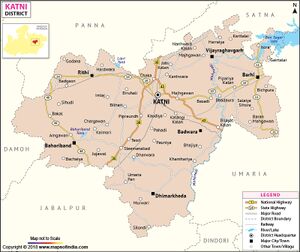Tigawa

Tigawa (तिगवा) is a village in Bahoriband tahsil of district Katni, Madhya Pradesh.
Contents
Variants
Origin
The name Tigawa (Tigowa, Tigoan, Tigwan) may be derived from "Tri-gawa" or "three villages", referring to the neighboring villages of Amgowa and Deori.
Location
The Tigawa temples site is in the eponymous village Tigawa, also called Tigwan, in the Katni district and 4 kms north of the town of Bahuriband. It is about 50 kms west of Katni, 70 kms north of Jabalpur.
History
The site is located on a plateau near the Kaimur range of hills, with belts of rocks, where ancient Indians used the local geology to build numerous small dams to harvest rainwater into water reservoirs that locals call jhils. These reservoirs extend from Bahuriband to the north of Tigawa. The local tradition is that there was in the distant past a large city in that location, which would explain the numerous mounds found in their region and when excavated, these mounds have yielded broken pottery and bricks. Alexander Cunningham speculated in 1879 that the Bahuriband (also Bahulaband, about 4 kms south of Tigawa) may have been the city that Ptolemy transliterated as Tholabana.[1]
Local tradition believes that it once had a fort and it was part of a major town named Jhanjhangarh, a suburb of ancient Bahuriband.[2]
Tigawa is an archaeological site with a complex of about 36 Hindu temple ruins.[3] Of these, the ancient Kankali Devi Temple is in good condition, and is dated to about 400-425 CE.[4] Also referred to as Tigowa or Tigwan, the site is about 4 kms north of Bahuriband between Katni and Jabalpur. The Hindu temple ruins were badly damaged during a colonial era railway project when a contractor demolished and excavated the ruins as building material for the railway project.[5]
Of the monuments, the Kankali Devi Temple is most notable and is a Gupta period temple.[6][7][8] It is one of the oldest surviving Hindu temples,[9] illustrating the formative stages of Hindu sacred architecture and the essential elements found in the north Indian style through the modern era.[10]
तिगवा
विजयेन्द्र कुमार माथुर[11] ने लिखा है.... तिगवा एक छोटा-सा गाँव है, जो मध्य प्रदेश के जबलपुर ज़िले से लगभग 40 मील दूर स्थित है। तिगवां गुप्त काल में जैन सम्प्रदाय का केन्द्र था। एक अभिलेख से ज्ञात होता है कि कन्नौज से आए [p.400]: हुए एक जैन यात्री 'उभदेव' ने पार्श्वनाथ का एक मंदिर इस स्थान पर बनवाया था, जिसके अवशेष अभी तक यहाँ पर विद्यमान हैं। यह मंदिर अब हिन्दू मंदिर के समान दिखाई देता है। यहाँ के खंडहरों में कई जैन मूर्तियाँ भी प्राप्त हुई है।
मंदिर का वर्णन करते हुए स्वर्गीय डॉक्टर हीरालाल ने लिखा है कि "यह प्राय: डेढ़ हज़ार वर्ष प्राचीन है।" यह चपटी छतवाला पत्थर का मंदिर है। इसके गर्भगृह में नृसिंह की मूर्ति रखी हुई है। दरवाज़े की चौखट के ऊपर गंगा और यमुना की मूर्तियाँ खुदी हुई हैं। पहले ये ऊपर बनाई जाती थीं किन्तु पीछे से देहरी के निकट बनाई जाने लगीं। मंदिर के मंडप की दीवार में दशभुजी चंडी की मूर्ति खुदी है। उसके नीचे शेषशायी भगवान विष्णु की प्रतिमा उत्कीर्ण है, जिनकी नाभि से निकले हुए कमल पर ब्रह्मा विराजमान हैं। [12]
श्री राखालदास बनर्जी[13] के अनुसार इस मंदिर में एक वर्गाकार केन्द्रीय गर्भगृह है, जिसके सामने एक छोटा-सा मंडप है। मंडप के स्तम्भों के शीर्ष भारत-पर्सिपोलिस शैली में बने हुए हैं, जिससे यह मंदिर गुप्त काल से पूर्व का जान पड़ता है। (द एज ऑफ इंपीरियल गुप्ताज-पृ.153)
यह कभी मन्दिरों का गाँव था, किंतु अब यहाँ लगभग सभी मन्दिर नष्ट हो गये हैं। तिगवां में पत्थर का बना विष्णु मन्दिर 12 फुट तथा 9 इंच वर्गाकार है। ऊपर सपाट छत है। इसका गर्भगृह आठ फुट व्यास का है। उसके समक्ष एक मण्डप है। इसके स्तम्भों के ऊपर सिंह तथा कलश की आकृतियाँ हैं। इस मन्दिर में काष्ठ शिल्पाकृतियों के उपकरण का पत्थर में अनुकरण, वास्तुशिल्प की शैशवावस्था की ओर संकेत करता है।[14]
Monuments
Notable persons
References
- ↑ Cunningham, Alexander (1879). Report of a Tour in the Central Province in 1873-74-75-76 (Vol IX). Archaeological Survey of India. New Delhi, pp. 39-43; This article incorporates text from this source, which is in the public domain.
- ↑ Cunningham, Alexander (1879). Report of a Tour in the Central Province in 1873-74-75-76 (Vol IX). Archaeological Survey of India. New Delhi, pp. 39-43; This article incorporates text from this source, which is in the public domain.
- ↑ Cunningham, Alexander (1879). Report of a Tour in the Central Province in 1873-74-75-76 (Vol IX). Archaeological Survey of India. New Delhi, pp. 41-47;
- ↑ Francis D. K. Ching; Mark M. Jarzombek; Vikramaditya Prakash (2010). A Global History of Architecture. John Wiley & Sons. pp. 227–228. ISBN 978-1-118-00739-6.
- ↑ Cunningham, Alexander (1879). Report of a Tour in the Central Province in 1873-74-75-76 (Vol IX). Archaeological Survey of India. New Delhi, pp. 41-47;
- ↑ Momin, A R, The Legacy of G.S. Ghurye: A Centennial Festschrift. 1996.
- ↑ Ramanujan, S R, The Lord of Vengadam: A Historical Perspective. Partridge Publishing, 2014.
- ↑ Prakash, Om, Cultural History of India. 2005.
- ↑ Francis D. K. Ching; Mark M. Jarzombek; Vikramaditya Prakash (2010). A Global History of Architecture. John Wiley & Sons. pp. 227–228. ISBN 978-1-118-00739-6.
- ↑ George Michell (1977). The Hindu Temple: An Introduction to Its Meaning and Forms. University of Chicago Press. pp. 94–96. ISBN 978-0-226-53230-1.
- ↑ Aitihasik Sthanavali by Vijayendra Kumar Mathur, p.399-400
- ↑ (दे. जबलपुर ज्योति,पृ.140)
- ↑ See:Age of the Imperial Guptas, p.153
- ↑ भारतकोश-तिगवा